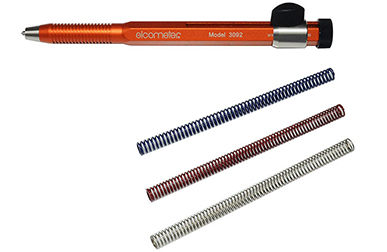Elcometer 3092 Sclerometer Hardness Tester

Product Description
The Elcometer 3092 Sclerometer Hardness Tester measures the hardness of a coating by moving a Tungsten Carbide Tip over the coating with predetermined force.
The body of the hardness testing instrument contains a cursor fitted with a screw lock and a round tip, compressed by one of the four springs corresponding to the four printed scales:
• Grey spring: 0-3N
• Red spring: 0-10N
• Blue spring: 0-20N
• Green spring: 0-30N
The spring force can be set by the “collar”; compressing the spring, increases the force with which the tip is pushed on to the surface of the test piece.
By making short, straight movements while gradually increasing the load, the user can observe the force at which the tip leaves a mark or destroys the coating.
Each Elcometer 3092 Sclerometer Hardness Tester is supplied in a case with a 0.75mm diameter tungsten carbide tip and 3 springs (grey, red and blue). An optional green spring of 0 – 30N is also available.
The Elcometer 3092 Sclerometer Hardness Tester can be used in accordance with:
|  |
Specifications
| Part Number | Description |
| K0003092M201 | Elcometer 3092 Sclerometer Hardness Testers – 3 ranges |
| Dimensions | 165 x 24 x 16mm |
| Weight | 370g |
Packing List
- Elcometer 3092 Sclerometer
- Tool with 0.75mm diameter tungsten carbide tip
- 3 springs (grey, red and blue)
- Carry Case
- Operating Instructions
Data Sheet
Standards
The Elcometer 3092 Sclerometer Hardness Tester can be used in accordance with:
• AS 3894.4
• EN 438-2
• ISO 4586-2
Accessories
| Part Number | Description |
| KT003092P001 | 0.5mm Tungsten Carbide Tip |
| KT003092P002 | 0.75mm Tungsten Carbide Tip |
| KT003092P003 | 1.0mm Tungsten Carbide Tip |
| KT003092P008 | 90° Diamond Point Cone, 90µm Radius – ISO Type |
| KT003092P004 | Grey Spring 0 – 3N |
| KT003092P005 | Red Spring 0 – 10N |
| KT003092P006 | Blue Spring 0 – 20N |
| KT003092P007 | Green Spring 0 – 30N |
| KT003092P001 | 0.5mm Tungsten Carbide Tip |
| KT003092P002 | 0.75mm Tungsten Carbide Tip |
| KT003092P003 | 1.0mm Tungsten Carbide Tip |
| KT003092P008 | 90° Diamond Point Cone, 90µm Radius – ISO Type |
| KT003092P004 | Grey Spring 0 – 3N |
| KT003092P005 | Red Spring 0 – 10N |
| KT003092P006 | Blue Spring 0 – 20N |
| KT003092P007 | Green Spring 0 – 30N |
Instruction Manual
Video
The Elcometer 3092 Sclerometer Hardness Tester measures the hardness of a coating by moving a hardened tip over the coating with predetermined force.
The coating is then visually examined for damage. The harder the coating, the greater the force required to scratch it.
To begin testing, you need to select a spring, and set the tip force. There are four springs of varying ranges available for use with the Elcometer 3092, and the stiffness of each is identified by their colour:
Grey spring: 0-3N
Red spring: 0-10N
Blue spring: 0-20N
Green spring: 0-30N*
*Each Elcometer 3092 Sclerometer Hardness Tester is supplied in a case with a 0.75mm diameter tungsten carbide tip and 3 springs (grey, red and blue). The green spring of 0 – 30N is also available as an optional accessory.
Typically, you should start testing with the softest spring.
The spring force can be set by the “collar”; compressing the spring increases the force with which the tip is pushed on to the surface of the test piece.
To insert the spring into the sclerometer, first loosen the locking screw on the side, remove the end cap, and slide the collar off. If there is already a spring inside the sclerometer, remove it and store in the case provided, and then insert the appropriate spring in its place. Refit the collar, ensuring the bevelled edge goes on first, replace the end cap, and then locate the scale on the sclerometer which matches the colour of your chosen spring.
Simply slide the collar to the required setting on the scale, and tighten the locking screw to set the tip force – typically you start testing with a smaller force, and work upwards.
Remember, the scratch method is a destructive test and will damage the coating, so we recommend using test panels when testing using this method.
Place the sclerometer onto the coating. Move the gauge across the surface to produce a linear scratch approximately 10mm long. Then remove the gauge, and examine the coating.
If the surface is unmarked, use the collar on the Elcometer 3092 to increase the spring loading, and repeat the test until surface marking is detected.
The Elcometer 3092 is supplied with a Tungsten Carbide tip as standard, however an ISO type 90° Diamond Point Cone tip is available, allowing you to obtain results equivalent to EN 438-2, and ISO 4586-2.
Please note, while this video is a guide on how to use a sclerometer, we recommend you always refer to the test method or Standard you are working to directly, before testing.
